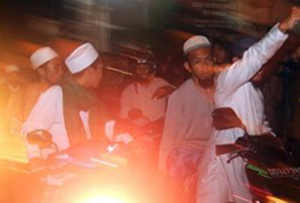
Ulma Haryanto
JAKARTA: The Indonesian media must learn from the mistakes made in covering the bloody sectarian conflict in Ambon as it seeks to report on the disturbing increase in similar interreligious violence breaking out across the country, experts say.
Eni Mulia, executive director of the Association for National Media Development (PPMN), told the Jakarta Globe on Wednesday that most of the media coverage of these disputes touched only on the violence itself, without putting into context why it erupted or how it could be resolved.
"Religious conflicts happen almost every day or at least every other day, yet no newsroom in this country has the capacity or resources to facilitate open discussion of this topic, while some chose to avoid it altogether," she said at a training seminar.
"So we feel it would be right to train journalists on how to act or face conflicts to find a peaceful resolution in covering religious conflicts."
Eriyanto, a researcher from the Indonesian Survey Circle and one of the guest speakers at the seminar, elaborated on the role of the mass media in covering the bloody sectarian conflicts in Sampit, East Kalimantan, and Ambon, Maluku.
Reports of fatalities from the Ambon conflict, which ran from 1999 to 2006, vary from 4000 to as much as 10,000, while an estimated 860,000 people were displaced.
"When regions in Ambon were segregated into Muslim and Christian areas, the media became a tool for propaganda," Eriyanto said.
He added this role was filled by fundamentalist media outlets such as the Voice of Maluku Muslim Crusaders, a radio station backed by the Laskar Jihad.
The latter, who have since been disbanded, were a Java-based militant Islamic group that fueled the Ambon strife by recruiting and sending a constant stream of fighters to the conflict zone.
Eriyanto said his research showed that 80 percent of reporters who filed stories on that conflict were not always writing from the scene, but were basing their reports mostly on witness accounts that were subjective, one-sided and often simply hearsay.
"At a time when it was dangerous, even life-threatening, to go to the other religion's area, these journalists, who were obviously unprepared for covering a religious conflict, could only rely on their limited sources," he said.
"False or unverified news only made the situation worse, while reporters became emotionally involved and could only report from their own areas."
Ambon today remains relatively sensitive to religious strife and its Muslim and Christian communities continue to live in segregation, as confirmed by two Ambon reporters taking part in the seminar: Firman Attamimi from the Ekspresi Ambon daily and Harry Radjabaycolle, a contributor for Jakarta-based TVOne .
"This is why I joined the seminar," Firman said.
"I think that of all the provinces in Indonesia, Ambon is one of the most conflict-prone areas and that's also why peace journalism has become important, because it teaches reporters how to stay balanced in covering these kinds of incidents."
The seminar, held from Jan. 24 to 28, drew journalists from across the country. Among those invited to speak were Ihsan Ali Fauzi from Paramadina University and Burhanuddi Muhtadi, an analyst with the Indonesian Survey Institute.
Others served as mentors for participants, including Tempo editor Jajang Jamaludin, Media Indonesia deputy director for daily news Usman Kansong and Ade Wahyudi, from radio station KBR68H.
Former Jakarta Legal Aid Foundation (LBH) director Asfinawati spoke on the legal framework for religious freedom, while Ahmadiyah's Zafrullah Ahmad Pontoh, Indonesian Churches Union (PGI) member Gomar Gultom, and Dewi Manti, representing the animist Sunda Wiwitan, sect, spoke about the challenges facing their respective religions. - Jakarta Globe/Pacific Media Watch



